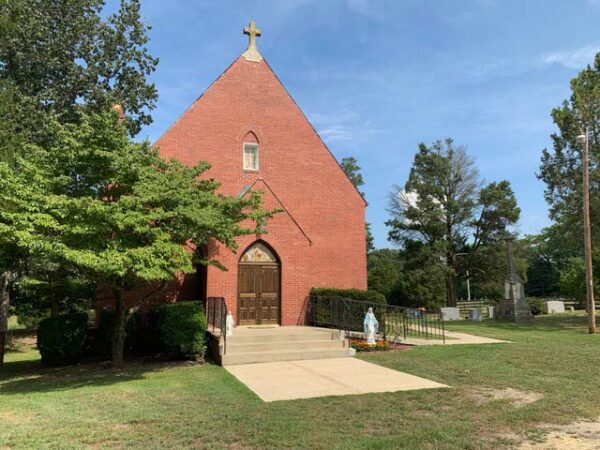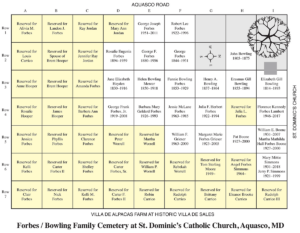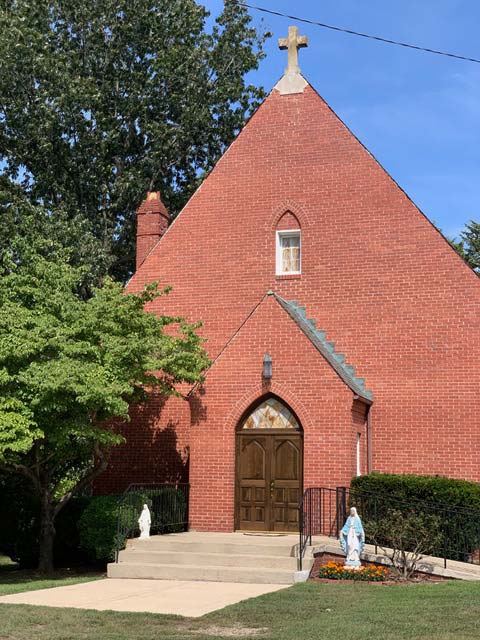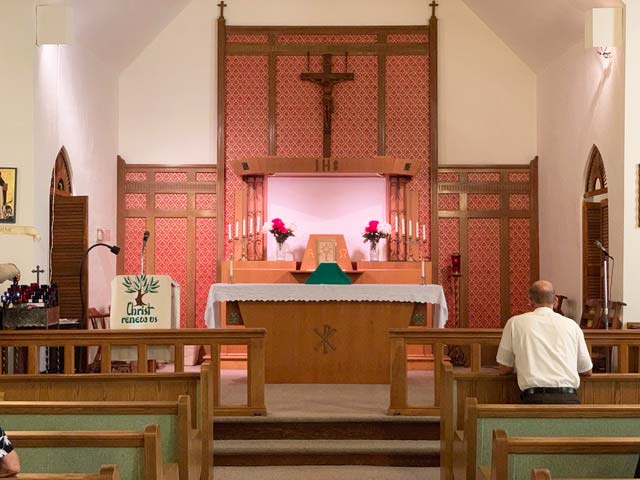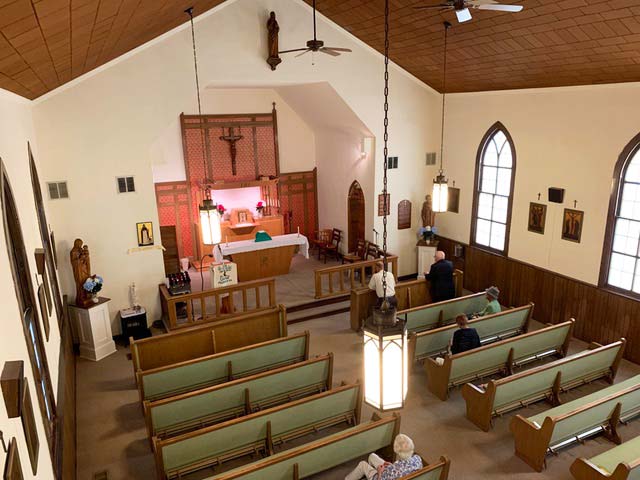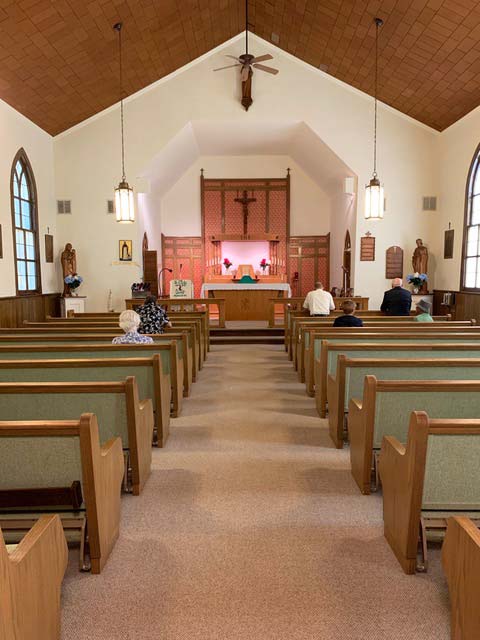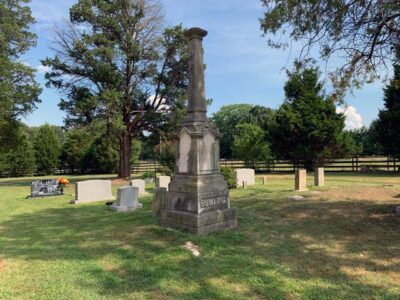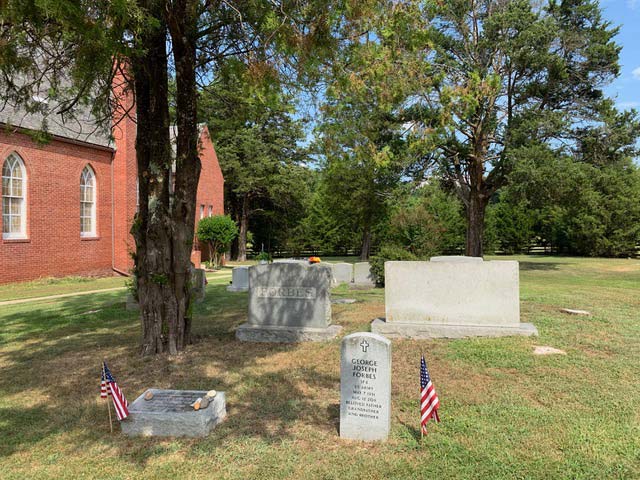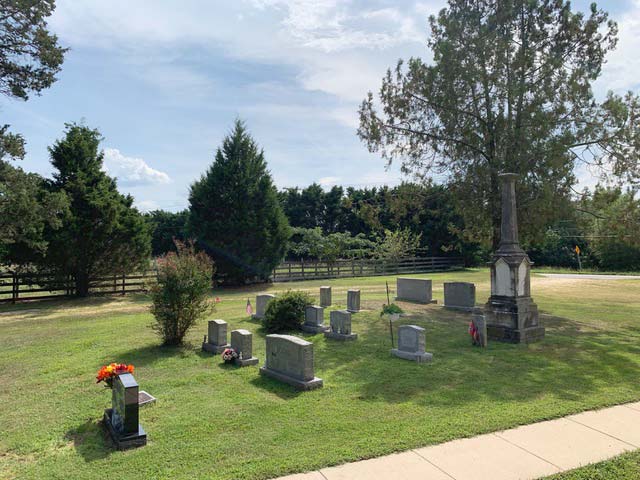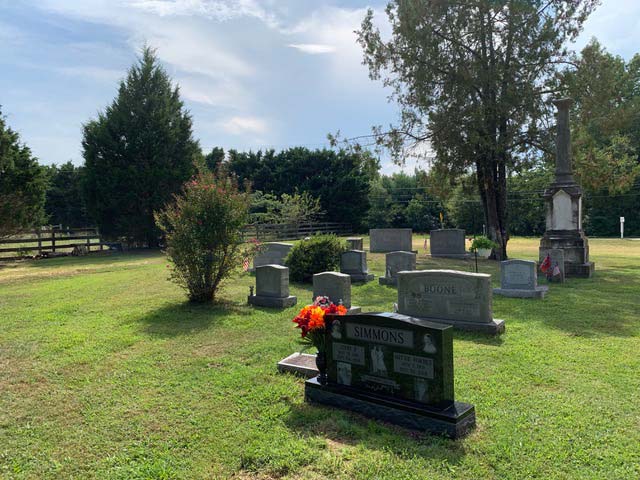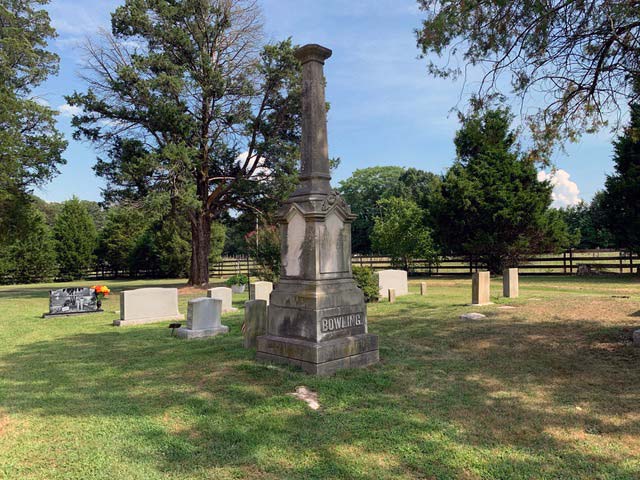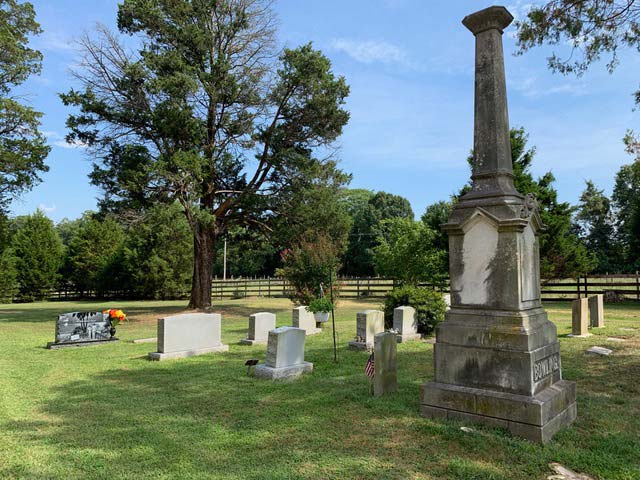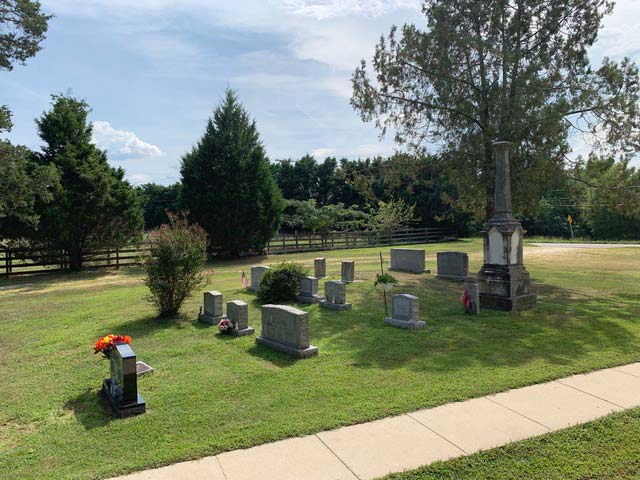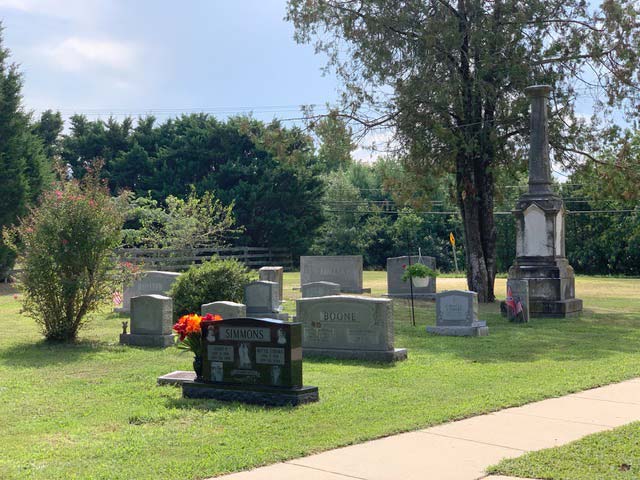History of St. Dominic’s Roman Catholic Church in Aquasco, MD
By the 1870s, Baltimore was the second largest city in the entire United States (second only to New York). The Catholic Diocese of Baltimore encompassed every state along the east coast from New England to Louisiana. Colonel John Dominic Bowling, a devout Catholic, lived all of his life in Woodville (now named Aquasco) without a Catholic Church nearby. His children were baptized Catholic, but since his wife, Elizabeth Gill, was an Episcopalian, they attended the local Episcopal church. When Colonel Bowling died in 1875, he left his son $1,000.00 with the instruction that this money was to be used to build a Catholic church on his property, now Villa de Sales. A wooden church was subsequently erected on 1-acre of land which was given/transferred to Archbishop of Baltimore, James Cardinal Gibbons. The land selected for gifting to the church was where Colonel Bowling himself was buried.
In 1879, St. Dominic’s Church and Cemetery were dedicated by James Cardinal Gibbons for the Bowling Family. Colonel Bowling gave this property to the Church with the stipulation that only members of the Bowling family, their descendants, and their spouses would be buried there. This tradition has continued until present time as is evidenced by the family names marked and the history of which persons have been allowed to be buried there (see early history article below). The small acreage would not accommodate many graves, but this was considered appropriate as not all family members may choose to be buried there. Around 1986, Colonel Bowling’s great-granddaughter and parishioner, Mittie Forbes Simmons, donated additional acreage from the adjacent Villa De Sales farm to accommodate more car parking at the church.
As a Mission Church, St Dominic’s has over the years been attached to a number of Parish churches: St. Peter’s, Beantown; St. Mary’s, Bryantown; and St. Francis de Sales, Benedict. At the present time, it is a mission of St. Michael’s, Horsehead.
Canonically Established:
- 1879–1920 as a Mission of St. Peter Catholic Church, Waldorf, MD;
- 1920-1973 as a Mission of St. Francis de Sales, Benedict, MD;
- 1974—present as a Mission of St. Michael, Baden, MD
Location
22400 Aquasco Road
Aquasco, MD 20608
Website: https://stmichaelbaden.org
The Early History of
St. Dominic’s Roman Catholic Church
Aquasco (formerly Woodville),
Prince George’s County, MD
1875 to 1931
by Vivian and Edward B. Edelen
The early history of St. Dominic’s Roman Catholic Church, in Aquasco (formerly Woodville), in Prince George’s County, Maryland, is truly the history of a family.
In his will signed the nineteenth of February 1874, Colonel John Dominic Bowling, Sr., devised as follows:
“And in case a Roman Catholic Church is not built in said Woodville, during my lifetime, I give to my son, John Bowling, the sum of one thousand dollars, with the request, that he will apply that sum towards the erection of a Roman Catholic Church in said place.” (Prince George’s Co. Wills—Liber WAJ,folio 44).
This will was probated the ninth of February 1875 after Colonel Bowling’s death the fifth of January 1875, at his home, “White Hall”, in the village of Woodville.
To understand the reasons for this bequest it is necessary to know something about the man himself. John Dominic Bowling was born at his family’s estate near Bryantown, in Charles County, Maryland, on the 26th of December in 1805. His parents, James Marsham Bowling (1772–1847) and Margaret Boarman (1763–1819), were parishioners of St. Mary’s Church, at Bryantown, where their nearly identical tombstones in the old cemetery there mark their graves. Their nine children, of which John Dominic was the fourth, were reared in the Roman Catholic faith.
When John Dominic Bowling grew to manhood, however, he married an Episcopalian, Elizabeth Gill, on 10 April 1832, at W.R. Barker’s home, in St. Paul’s Parish, in Prince George’s County, according to the Register of Trinity Church, Volume II. After their marriage, they lived in a beautiful home called “White Hall”, in the center of Woodville. The home was destroyed by fire about 1912.
Although John Dominic Bowling had not been married in the Catholic faith, most of his thirteen children were baptized by the priests serving the Bryantown parish, there being no Catholic Church in the village of Woodville. The priests serving at St. Mary’s Church at the time the children were baptized were: Reverend Francis Roloff, from 1829 to 1842; Reverend Patrick Courtney, from 1842 to 1854, according to a book, A MODEL COUNTRY PARISH AND ITS RECORDS, by Rt. Rev. Owen B. Corrigan, D.D.V.G., Auxiliary Bishop of Baltimore. This book was reprinted with permission from Records of the American Catholic Historical Society, 714 Spruce Street, Philadelphia, Sept. No. 1924.
In the REGISTER OF BAPTISMS 1793–1861, at St. Mary’s Rectory, Bryantown, the following children of Colonel Bowling and his wife are recorded as having been baptized as shown, but it must be noted that there are three whose baptisms are not recorded. The birth dates for them and the death dates for all are copied from Colonel Bowling’s family Bible:
- Mary Margaret—b.9 Jan.1833; d.28 Sept.1841—no record
- John-Henry—b.12 Jan.1835; d.17 July 1837—bapt.3 June 1836; Marsham Bowling and his 2nd wife, Sarah Dyer Jameson were sponsors. (P.81 of Reg.)
- John (twin)—b.21 Feb.1837; d.26 Feb.1887
- Henry(twin)—b.21 Feb.1837; d.15 Oct.1864—both of them were bapt. 9 Aug.1837; Marsham Bowling sponsor (P.82 of Reg.)
- Charity Ann—b.11 Mar. 1839; d. ?. —bapt. 31 May1840 (P.86)
- Elizabeth Childs—b.7 Apr.1841; d.26 Aug.1894—no record
- Mary—b.16 Feb.1843; d.25 June 1843—bapt.22 June 1843 (P.90 of Reg.)
- Martha Chunn—b.27 Apr.1844; d.13 July 1867—bapt.2l Oct.1844 (P.92 of Reg.)
- Richard—b.13 Jan.1847; d.4 Nov.1855—bapt. Jan.1847 (P.95 of Reg.)
- Gustavus Marsham—b.14 Dec. 1848; d.25 July 1849–bapt. July 1849 (P.99 of Reg.) Jane Hayden sponsor
- Helen—b.14 July 1850; d.26 Apr.1918—bapt. July 1851 (P.1OO of Reg.) Jane Hayden sponsor
- Frances—b.7 Mar. 1853; d.18 Apr.1929—bapt. Dec. 1853 (P.103 of Reg.) Rev. Patrick Courtney sponsor
- Erasmus Gill—b.23 July 1855; d.29 Nov.1894—no record
During the early 1800’s there was no regular pastor at St. Mary’s Church and not all baptisms were recorded, but Mary Margaret Bowling was buried in old St. Mary’s cemetery, as were the other children who died at young ages, probably. She is the only one, however, for whom a tombstone still stands.
With no Catholic Church in Woodville, it seems that none of these children were able to attend Mass. A daughter of Frances Bowling in later years stated that her mother and Aunt Helen (called “Nina”) became “converts” after they were sent to the Catholic boarding school, Mount de Sales, in Catonsville, Maryland. Years later these records of their baptisms prove that these children received the sacrament in infancy. Whether the older daughters and sons were sent to any Catholic boarding schools has not been ascertained. Most of the daughters married Episcopalians, so it would seem that Elizabeth Gill Bowling reared her children in that faith rather in that of her husband—hence the impressions that the two youngest girls were converts.
Perhaps because he was not married in the Church and could not give his children the advantage of attending Mass in their early years, Colonel Bowling tried to make amends by bequeathing money for a church in his little village. One cannot help wondering why he did not donate money for erecting such an edifice earlier in his lifetime. He was a very wealthy man, having acquired a great acreage in land, many securities, and a profitable income. When he wrote his will in 1874 (see Prince George’s County Wills, Liber WAJ, f.44), he bequeathed either $25,000.00 in cash or the equivalent in land and buildings to each of his surviving children, as well as providing well for his widow. He died a year after he wrote his will, so it was left to his son, John Bowling (1837-1887), of Upper Marlborough, to carry out the terms of his will for the erection of a church.
In the Land Records of Prince George’s County, at Upper Marlboro, there is proof that John Bowling executed his father’s will. The deed to the land for the erection of the church reads as follows: (Liber ATB- No. 1 Folio 272)
“This deed made the 30th day of May in the year of Our Lord 1879 by and between John Bowling and Christina J. Bowling, his wife, of Prince George’s County in the State of Maryland on the one part, and the Most Reverend James Gibbons, Archbishop of Baltimore City, in the State of Maryland, of the other part, Witness that the said John Bowling and his wife for and in consideration of many divers good causes as there unto moving and no further consideration of the sum of five dollars to said John Bowling in hand paid receipt of which is hereby acknowledged, do give grant and confirm unto said The Most Reverend James Gibbons, Archbishop of Baltimore, all that part or tract or parcel of land hereuntofore particularly described as part of a lot of land formerly belonging to William R. Burker, late of said County deceased, situated in the Village of Woodville in said County and which has conveyed to said John Bowling by John Dominic Bowling Trustee by deed the twenty-fourth of May 1873 and recorded in Liber HB, No. 7, folio 233, one of the land records of the said County and aforesaid portion of said lot hereby intended to be conveyed being situated on the northwest corner of said lot of land and fronting upon the main street of Woodville and being contained within the following meters and boards and courses and distances to wit: Beginning from said stake in the middle of the main street of Woodville said stake being end of 15 line of George Forbes’s recent purchase and with his 15 and 14 line reversed N.82 1/4 degrees East 17 perches to a stake N. 7 3/4˚, 9 8/25 perches to a stake, S. to 82 1/4 degrees W.18 2/10 perches to center of aforesaid street and with said street S. 16 degrees East 9 2/5 perches to the beginning, containing one acre as surveyed by William J. Latimer in February 1877. To have and To Hold the above-designated Lot part of lot or parcel of land—the said James Gibbons, Archbishop of Baltimore, and his successor forever in fee simple to be held and used for the purchase of a Catholic Church and to and for no other use intent or purpose whatsoever, reserving however from the grant and conveyance the present Grave of said John Dominic Bowling deceased where his remains are now interred and so long as his family and friends may desire his said remains there to remain.
Witnesseth our hands and seals
John Bowling
Christina J. Bowling
Testament: James H. Ritchie
Joseph H. Roberts, Jr.
Enrolled 30th of May A.D. 1879 James H. Ritchie, J.P.
John and Christina J. Bowling appeared.
As is indicated by the last sentence in this deed, John Dominic Bowling already had been interred in the area where the said church was to be erected, having died on the 5th of January 1875. It is to be assumed that after the area was surveyed in 1877, the little church was built, a carpenter having been secured by the son of Colonel Bowling, probably. A white cornerstone bearing the date of “A.D. 1879” at the present brick church and the following excerpt from a book about another parish are proof that the project was completed in that period.
The book, A MODEL COUNTRY PARISH AND ITS RECORDS by Rt. Rev. Owen B. Corrigan, D.D., V.G., Auxiliary Bishop of Baltimore, reprinted, with permission, from the Records of the American Catholic Historical Society, 715 Spruce Street, Philadelphia, September Number, 1924, is a history of St. Mary’s Church, at Bryantown primarily, but on page 29 the following information is recorded:
“The church of St. Dominic at Woodville was dedicated by His Eminence James Cardinal Gibbons, September 10, 1879. According to the C.D. (Catholic Directory originally called Catholic Almanac and Laity Directory), it was attended at first from Beantown, but from 1883 to 1891 it was attended to Bryantown. Then, from 1891, it continued to be a mission of Waldorf, till 1920, when it was united to Benedict.
“When Father Martin was relieved of Woodville, he built a little church at Baden also in Prince George’s County, which had been for a number of years the principle one of the Cathechism Centres established by him in several parts of his parish.”
A picture of the church that was erected shows that it was of wooden frame construction and measured approximately 56 feet by 38 feet in the main section and was in a T-shape form like a cross. The outside was covered with German siding and the roof had shingles of wood. The arched windows had wooden shutters which were kept closed except when services were held. Three wooden steps led into the vestibule which was about 12 feet in size, at the entrance to the church. The vestibule had small windows on each side and double doors set in an arched doorway surmounted by an inverted V-shaped roof with simple victorian trim. Above the vestibule there was a stained glass rose window set in a triangular frame, over which rose a high pointed roof surmounted by the traditional cross. A wooden fence and gate was erected across the front of the property.
The sacristy area at the right-rear of the church was entered by a door on the part facing the road. Five wooden steps led up to a simple wood door where the priest entered to don his vestments. A wardrobe, table and chair were there for his convenience. The room on the opposite side of the back of the church was where the devotional objects were kept–statues, rosaries, holy water fonts, prayer books. This room was opened to the public after services during retreats or missions so that parishioners could purchase what they needed.
The sanctuary had a plain wooden altar with a carved front, mounted two steps above the main church floor. The communion rail was of dark wood with a white linen cloth tacked to the side of the railing facing the back of the sanctuary. This cloth was thrown forward before Mass started. Communicants would reach under the cloth and hold it under their chins when receiving communion because there were no altar boys to hold the paten under the host. Communicants knelt on the first steps in front of the dark wooden railing. A tabernacle of wood was built into the altar, but the Blessed Sacrament was never left there. The visiting priest came only every two weeks in winter, and each weekend during summer to this little, mission church.
The wooden pews in the main area of the church reached from the center aisle to the wall on each side. Each family sat in a certain pew.
The confessionals were on either side of the entrance area of the church and had no doors, just velvet curtains. There was a choir loft above these with an organ. Two granddaughters of Colonel Bowling often sang during Mass—Mary Eleanor Forbes, soprano; Elizabeth Gill Forbes, alto.
There was no covering on the wood floor of the church, which was heated on cold days by a pot-bellied stove in the corner near the sacristy. Coal was the fuel. Except for the altar candles, there were no lights because no night services were held. The church sexton was Albert Tolson.
Flowers for the altar often came from the garden of “Haydie” (Miss Jane Hayden, governess for some of Colonel Bowling’s children and grandchildren) who lived at “Selma”, the Mercer home in Woodville, in her later years.
Cathechism classes were held during the summer for the Catholic children in the Woodville, Baden, Nottingham and Westwood area. Sisters from Baltimore came on the train to Waldorf, in Charles County, and stayed at St. Peter’s Church Rectory. Classes were held on Saturday at St. Peter’s during the morning; then the Sisters were taken by carriage, by the sexton at St. Peter’s, to Woodville where classes were held at St. Dominic’s in the afternoon. The Sisters returned to Baltimore on Sunday afternoon by train.
A history of this little country church would not be complete without an explanation about its tiny cemetery. According to family tradition, only the immediate members of Colonel Bowling’s family were to be buried there in the area to the right of the church, as one enters.
It is possible that the Archbishop had made that stipulation. It is known, however, that, in later years, special permission had to be received for some of the family to be interred there, so some stipulation must have been made by someone previously. Perhaps due to the fact that Colonel Bowling had married out of the church and then had given money for the erection of the church on his land, he had been granted privilege of having his wife buried next to him. At first just he, Elizabeth Gill and their son, Erasmus Gill Bowling, were the only ones buried there. A tall obelisk-type of tombstone bears these inscriptions: (on three sides of the marker)
Sacred to the Memory of John D. Bowling
Born 26th Dec. 1805
Died 5th Jan. 1875
May He rest in peace
Sacred to the Memory of Elizabeth Gill Bowling
Born Jan. 20, 1814
Died Oct. 18, 1893
May She rest in peace
Gill Bowling
Sacred to the Memory of E. Gill Bowling
Born July 23, 1855
Died Nov. 29, 1894
He giveth His beloved son
The next person to be buried there was Jane Elizabeth Hayden, who had been a governess in the Bowling, Forbes, and Mercer families. There was much consternation about whether she could be interred in this plot, even though she was a Catholic, but consent was given and her tomb was inscribed:
Jane Elizabeth Hayden
1830–1916
Eternal Rest Grant To Her O Lord
Two years later Col. Bowling’s daughter, Helen (called “Nina”) died and there was no question about her burial there. Her marker bears this inscription:
Helen Bowling Mercer
Beloved Wife of
G.D. Mercer
July 14, 1850
April 26, 1918
Her husband, Major George Douglas Mercer, an Episcopalian, however was not interred in that plot when he died three years previous to her demise. His grave is in the Mercer plot at St. Mary’s Episcopal Church in Woodville and has a plain marker inscribed with only his name and the dates 1831–1915.
When Colonel Bowling’s daughter, Fannie Bowling Forbes, died in 1929, she was buried near her sister and parents. Her husband, George Forbes, an Episcopalian, died two years later and it was very doubtful that he could be buried next to her. His three surviving children, Mary Eleanor Forbes (Mrs. Charles Albert Bowling), Elizabeth Gill Forbes (Mrs. Edward George Edelen), and George Francis Forbes, all of whom were faithful Catholics finally received permission for his burial beside his dearly beloved wife. A granite tomb marks their graves.
George Forbes
Oct. 5, 1844–April 8, 1931
Fannie Bowling
March 7, 1853–April 18, 1929
Rest in peace
Colonel Bowling’s older daughter, Elizabeth Childs Bowling (1841-1894), is buried beside her husband, Charles Snowden Contee (1830-1886), in the Episcopal Church cemetery in Woodville, as are many of their family. John Bowling (1837-1887) died at his home, “Bowling Heights”,near Upper Marlboro, and is buried in the Mount Carmel Cemetery there. His twin, Henry Bowling (1837-1864), died in Richmond, Virginia, while serving in the Civil War, and is buried there. Martha (Mattie) Chunn Bowling (1844-1867) and her husband, Henry Waring Clagett (1840-1914) are buried at Mount Carmel in Upper Marlboro, also.
The last two members of Col. Bowling’s family to be interred at St. Dominic’s cemetery were his grandson, George Francis Forbes, and his wife, Rosalie Eugenia Hall. A large granite marker bears the name “Forbes” and footstones bear their names and dates:
Our Beloved
Husband/Father
George Francis Forbes
April 15, 1880
July 17, 1956
Our Beloved
Mother
Rosalie Eugenia Forbes
Oct. 24, 1894
Sept. 7, 1959
It is very fitting that Helen Bowling Mercer, Fannie Bowling Forbes, Rosalie Eugenia Hall Forbes, and Jane Hayden be buried near this church because for many years they cleaned it, took care of the altar linens and vestments, and housed the itinerant priests who served the parish. There was no rectory built for the church because it has remained a mission of other churches throughout the years. When Masses were to be held, the priests often spent the weekend at “Villa de Sales”, the beautiful Forbes home on the land adjoining the church property, or at “Selma”, the Mercer home.
As stated in the excerpt from the Catholic Directory, at first it was attended “from Beantown”, which means the St. Peter’s Church, near Waldorf. From January 1875 to 1883 the Reverend Henry Volz was the resident pastor at St. Peter’s, so he would have celebrated Mass at St. Dominic’s in its earliest years. A succession of priests served at St. Peter’s and St. Dominic’s during the ensuing years: Rev. Francis Tewes (pronounced “Tavis”) from 1878–1882; Rev. Edward M. Southgate 1882-1903 assisted by Rev. Stephen J. Clarke from April 1883-Nov. 1885; Rev. John J. Conway 1885-1889; and Rev. M.E. Stanton 1889. In Feb. 1894 a Frenchman of the Sulpician Order, Rev. N. Martin (pronounced “Martan”) served the two parishes and was frequently a beloved guest at the Forbes home. The hospitality shown these priests and the care that the Forbes family gave the church and grounds more than justifies the presence of these extra burials in Col. Bowling’s graveyard.
In 1920 the parishes of Benedict and Woodville were joined. The pastors resided at St. Francis de Sales Rectory, in Benedict, and celebrated Mass there and at St. Dominic’s at times convenient for both congregations.
This concludes the “early” history of St. Dominic’s and how it and its cemetery came into existence. After the death of Rosalie Eugenia Hall Forbes in 1959, her daughter, Martha M. (called “Patty”) Forbes and her husband, William Edward Boone, of ”Wiltshire Knoll”, on Route 233 north, between Bryantown and Woodville, took over the care of the little graveyard. The story from here on will be told by them because “Patty” grew up at the Forbes home, “Villa de Sales” and attended the church; thus, she knows St. Dominic’s more recent history and how it acquired its present brick exterior and renovated interior, and its present parishioners and priests.
Note:
The data covered here was compiled by Vivian and Edward B. Edelen from Prince George’s County Courthouse records, Bible and cemetery records, parish registers, and from pictures now located at their home, “Sunny Side Farm”, Bryantown, Md.
Edward B. Edelen is a great-grandchild of Col. Bowling and lived in Woodville from the time of his birth at the Forbes home, “Villa de Sales”, in 1906 until 1910 when he moved to his present home. His memories of the church and those of his mother, Elizabeth Gill Forbes Edelen, who was born at “Villa de Sales” in 1875 and remembered the church and its priests in its early days so well, add much to the foregoing account.
Other descendants of Col. John Dominic Bowling buried at St. Dominic’s Cemetery:
- Brother Henry A. Bowling
- Granddaughter Martha M. (“Patty”) Forbes with her husband, William Edward Boone
- Granddaughter Mittie Forbes Simmons with her husband, Jerry P. Simmons
- Granddaughter M. Marie. Forbes Greiser
- Grandson Robert Edward Lee Hall Forbes (Bobby) with his wife, Julia F. Forbes
- Grandson George Frank Forbes, Jr. with his wife, Barbara Mary
- Great-Granddaughter Florence K. Lambert
- Great-Grandson George Joseph Forbes
- Great-Grandson William F. Greiser
- Great-Grandson Jessie M. Forbes


